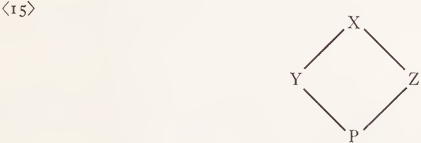


 Grammar
Grammar
 Tenses
Tenses
 Present
Present
 Past
Past
 Future
Future
 Parts Of Speech
Parts Of Speech
 Nouns
Nouns
 Verbs
Verbs
 Adverbs
Adverbs
 Adjectives
Adjectives
 Pronouns
Pronouns
 Pre Position
Pre Position
 Preposition by function
Preposition by function 
 Preposition by construction
Preposition by construction
 Conjunctions
Conjunctions
 Interjections
Interjections
 Grammar Rules
Grammar Rules
 Linguistics
Linguistics
 Semantics
Semantics
 Pragmatics
Pragmatics
 Reading Comprehension
Reading Comprehension|
Read More
Date: 2023-10-20
Date: 2023-12-26
Date: 2024-07-11
|
The examples we have discussed do not involve convergence within one hierarchy. That is, there are no instances of hierarchies like (15) in which the hierarchy branches at X and converges at P.

There are several reasons why convergent hierarchies are not tolerable. First, there are many instances in which a single lexical item is dominated by different words, e.g. (16):

If convergences were an acceptable part of the formalism, it would be possible to simplify (16) to (17):

But this would transfer to ‘ hands ’ all the selectional features of both ‘ humans ’ and ‘clocks’, many of which are mutually incompatible (notably ‘ ± animate’). Furthermore, if the senses of ‘hands’ are not distinguished we could not account for the oddity of sentences like:
(171) The clock’s face and hands are large but mine aren’t.
Maintaining distinct senses of lexical items in distinct lexical hierarchies is motivated independently of the consequences for convergent hierarchies. There are also motivations against convergent hierarchies within the same ‘lexical tree’. Consider the subsection of figure (5) in (18a):

‘Arm’ could dominate ‘joint’ directly on the Have dimension as in (18b) (as well (18) (b)

as via ‘limb’) since there is a sentence ‘an arm has a joint’. However, this would transfer to ‘joint’ all the properties pertaining to ‘arm’. This would in turn transfer all the features of ‘arm’ to ‘knee’, which is clearly incorrect.
The requirement that there are no convergences in the lexical hierarchy has the result that there are many distinct matrices in the lexicon which utilize the Have and Be hierarchies.1 There are many problems about these matrices which require further investigation. We have merely outlined the essential motivations for the hierarchies as lexical structures, and shown that convergent hierarchies cannot be included.
1 In fact, it might appear that an incorrect result follows from this restriction just in case a particular property or object is shared by many different words. For example, consider the word ‘electron’. Convergent hierarchies would allow this word to appear only once in the lexicon:

The restriction against convergent hierarchies would appear to force such a word to have multiple representation:

However, ‘electron’ does not appear many times, once under each object, rather only once under the word ‘object’ itself. Any other word that is an object automatically acquires the property of having electrons, by the assimilation rules discussed above.
|
|
|
|
دراسة تكشف "مفاجأة" غير سارة تتعلق ببدائل السكر
|
|
|
|
|
|
|
أدوات لا تتركها أبدًا في سيارتك خلال الصيف!
|
|
|
|
|
|
|
العتبة العباسية المقدسة تؤكد الحاجة لفنّ الخطابة في مواجهة تأثيرات الخطابات الإعلامية المعاصرة
|
|
|